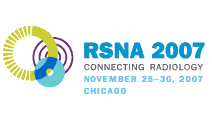
Abstract Archives of the RSNA, 2007
Thomas Josef Vogl MD, Presenter: Nothing to Disclose
Christophe Then Dipl Eng, Abstract Co-Author: Nothing to Disclose
Michael Schrodt Dipl Eng, Abstract Co-Author: Nothing to Disclose
GŁnther Benderoth Dipl Eng, Abstract Co-Author: Nothing to Disclose
Gerhard Silber MD, PhD, Abstract Co-Author: Nothing to Disclose
To document the interaction between human body and arbitrary support systems to design new anti-decubitus supports.
Measurements of stress-strain-data of human soft tissue are performed by a special device. Based on MRI data, 3D reconstructions of soft tissue regions in an unloaded and loaded state are generated. For calculating stress-and-strain distributions an FE model for a whole human body (dummy with soft tissue regions) is created, where the biomechanical behavior of soft tissue regions is described by a continuum mechanical model based on a strain energy function introduced by Ogden. The material parameters of the constitutive model are determined by a multiobjective quality function using an FE tool to solve the boundary value problem. Furthermore, a micro-perfusion measurement is carried out to detect mechanical conditions for occluding small vessels in the considered regions.
Comparison of the calculation of the predeletion sites (heel) on different supports made of various material combinations and varying geometries shows almost similar qualitative results, probably due to the purely elastic calculations. Viscoelastic calculations showed a different behaviour. On a representative section starting at the skin and ending at the calcaneus the highest load magnitude of the mean pressure as well as the von Mises stress is found at the bone site. This result complies with the fact that most ulcers start their development at this site. The current stress magnitude depends on the material and the geometric implementation of the support. Hence such a procedure can be used to optimize supports concerning the stress distribution in the interior of a predeletion site.
MRI, CAD and FE techniques on the stress-and-strain distributions inside human tissues on arbitrary support systems can be determined using continuum mechanical methods, thereby optimizing the procedure of anti-decubitus support based on MRI.
MR-based experimental data allow an innovative design of antidecubitus support systems.
Vogl, T,
Then, C,
Schrodt, M,
Benderoth, G,
Silber, G,
Development of an Innovative Method for Antidecubitus Support Design Using MRI: Technical Development. Radiological Society of North America 2007 Scientific Assembly and Annual Meeting, November 25 - November 30, 2007 ,Chicago IL.
http://archive.rsna.org/2007/5003498.html

